The Concept of Lineaments in Geological Structural Analysis; Principles and Methods: A Review Based on Examples from Norway
Abstract
:1. The Concept of Lineaments
2. Current Remote Sensing Technology in Geological and Structural Analysis
3. Different Approaches and Strategies in Structural Remote Sensing
4. General Study
5. Statistical Lineament Study
6. Focused Lineament Study
7. Dynamic Lineament Analysis
8. Technical Presumptions and Requirements in Lineament Analysis
9. Discussion
10. Conclusions
Author Contributions
Funding
Data Availability Statement
Acknowledgments
Conflicts of Interest
References
- O’Leary, D.W.; Friedman, J.D.; Pohn, H.A. Lineaments, linear, lineation: Some proposed new names and standards. Geol. Soc. Am. Bull. 1976, 87, 1463–1469. [Google Scholar] [CrossRef]
- Sabins, F.F., Jr. Remote Sensing. Principles and Interpretation; W.H. Freeman & Co.: New York, NY, USA, 1976; 426p. [Google Scholar]
- Al Khatieb, S.O.; Norman, J.W. A possible extensive crustal failure system of economic interest. J. Pet. Geol. 1982, 4, 319–327. [Google Scholar] [CrossRef]
- Bocaletti, M.; Bonini, M.; Mazzuoli, R.; Abebe, B.; Piccardi, L.; Tortoric, L. Quaternary oblique extensional tectonics in the Ethiopian Rift (Horn of Africa). Tectonophysics 1998, 287, 97–116. [Google Scholar] [CrossRef]
- Aydin, A. Failure modes of lineaments on Jupiter’s moon, Europa: Implications for the evolution of its icy crust. J. Struct. Geol. 2006, 28, 2222–2236. [Google Scholar] [CrossRef]
- Henriksen, H. Fracture lineaments and their surroundings with respect to groundwater flow in the bedrock of Sunnfjord, Western Norway. Nor. J. Geol. 2006, 86, 373–386. [Google Scholar]
- Gabrielsen, R.H.; Braathen, A. Models of fracture lineaments—Joint swarms, fracture corridors and faults in crystalline rocks, and their genetic relations. Tectonophysics 2014, 628, 26–44. [Google Scholar] [CrossRef]
- Gabrielsen, R.H.; Nystuen, J.P.; Olesen, O. Fault distribution in the Precambrian basement of South Norway. J. Struct. Geol. 2018, 108, 269–289. [Google Scholar]
- Gabrielsen, R.H.; Olesen, O.; Braathen, A.; Baranwal, V.C.; Lindholm, C. The Listafjorden-Drangedal Fault Complex of the Agder-Telemark Lineament Zone, southern Norway. A structural analysis based on remote sensing data. GFF 2019, 141, 200–215. [Google Scholar] [CrossRef]
- Meixner, J.; Grimmer, J.C.; Becker, A.; Schill, E.; Kohl, T. Comparison of different digital elevation models and satellite imagery for lineament analysis: Implications for identification and spatial arrangement of fault zones in crystalline basement rocks of the southern Black Forest (Germany). J. Struct. Geol. 2018, 108, 256–268. [Google Scholar] [CrossRef]
- Porwall, A.; González-Àlvarez, I. Introduction to special issue on remote sensing. Ore Geol. Rev. 2019, 105, 216–222. [Google Scholar] [CrossRef]
- Yeomans, C.M.; Head, M.; Lindsay, J.J. Application of the tilt derivative transform to bathymetric data for structural lineament mapping. J. Struct. Geol. 2021, 156, 104301. [Google Scholar] [CrossRef]
- Hobbs, W.H. Lineaments of the Atlantic border region. Geol. Soc. Am. Bull. 1904, 15, 483–506. [Google Scholar] [CrossRef]
- Hobbs, W.H. Earth Features and Their Meaning; MacMillan Co.: New York, NY, USA, 1912; 506p. [Google Scholar]
- Kjærulf, T. Udsigt over Det Sydlige Norges Geologi; W.C. Fabritius: Christiania, Denmark, 1879; 262p. (Including atlas). (In Norwegian) [Google Scholar]
- Hodgson, R.A.; Parker Gay, S.; Benjamins, J.Y. (Eds.) Proceedings of the First International Conference on the New Basement Tectonics, Salt Lake City, UT, USA, 3–7 June 1976; Geological Association: Salt Lake City, UT, USA, 1976; 636p. [Google Scholar]
- Gabrielsen, R.H.; Ramberg, I.B.; Roberts, D.; Steinlein, O.A. (Eds.) Proceedings of the Fourth International Conference on Basement Tectonics; International Basement Tectonics Association, Publication: Salt Lake City, UT, USA, 1983; 382p, No. 4. [Google Scholar]
- Mason, A. (Ed.) Basement Tectonics 7. Proceedings of the Seventh International Conference on Basement Tectonics, 1992, Kingston, Ontario, Canada, August 1987; International Basement Tectonics Association Publication: Salt Lake City, UT, USA, 1987; 288p. [Google Scholar]
- Oncken, O.; Janssen, C. (Eds.) Basement Tectonics Europe and Other Regions. Proceedings of the Eleventh International Conference on Basement Tectonics, Potsdam, Germany July 1994; Springer: Berlin/Heidelberg, Germany, 1996; 179p. [Google Scholar]
- Hall, J. Geophysical lineaments and deep continental structure. Philos. Trans. R. Soc. Lond. 1986, A317, 233–244. [Google Scholar]
- Deng, Y.; Xu, Y.-G.; Chen, Y. Formation mechanism of the North-South gravity lineament in eastern China. Tectonophysics 2021, 818, 229074. [Google Scholar] [CrossRef]
- Tian, J.; Ye, G.; Xie, C.; Li, L.; Wei, W.; Jin, S.; Liu, Z. Two-dimensional electrical resistivity structure of the crust and upper mantle across the North-South gravity Lineament in NE China. Tectonophysics 2022, 837, 229459. [Google Scholar] [CrossRef]
- Bouiflane, M.; Manar, A.; Medina, F.; Youbi, N.; Rimi, A. Mapping and characterization from aeromagnetic data of the Foum Zguiddolerite Dyke (Anti-Atlas, Morocco) a member of the Central Atlantic Magmatic Province (CAMP). Tectonophysics 2017, 708, 15–27. [Google Scholar] [CrossRef]
- Demarco, P.N.; Masquelin, H.; Prezzi, C.; Aïfa, T.; Muzio, R.; Loureiro, J.; Peel, E.; Campal, N.; Bettucci, L.S. Aeromagnetic patterns in Southern Uruguay: Precambrian-Mesozoic dyke swarms and Mesozoic rifting structural and tectonic evolution. Tectonophysics 2020, 789, 228373. [Google Scholar] [CrossRef]
- Montsion, R.M.; Perrouty, S.; Lindsay, M.D.; Jessell, M.W.; Frieman, B.M. Mapping structural complexity using geophysics: A new geostatistical approach applied to greenstonembelts of the southern Superior Province, Canada. Tectonophysics 2021, 812, 228889. [Google Scholar] [CrossRef]
- Nur, A. The origin of tensile fracture lineaments. J. Struct. Geol. 1982, 4, 31–40. [Google Scholar] [CrossRef]
- Ozkaya, S.I. Use of exclusion zones in mapping and modeling fracture corridors. Soc. Pet. Eng. 2010, 13, 679–687. [Google Scholar] [CrossRef]
- Ogata, K.; Senger, K.; Braathen, A.; Tveranger, J. Fracture corridors as seal-bypass systems in siliciclastic reservoir-cap rock successions: Field-based insights from the Jurassic Entrada Formation (SE Utah, USA). J. Struct. Geol. 2014, 66, 162–187. [Google Scholar]
- Souque, C.; Knipe, R.; Davies, R.K.; Jones, P.; Welch, M.J.; Lorenz, J. Fracture corridors and fault reactivation: Example for the Chalk, Isle of Thanet, Kent, England. J. Struct. Geol. 2019, 122, 11–26. [Google Scholar] [CrossRef]
- Sabins, F.F., Jr. Remote Sensing—Principles and Interpretation, 3rd ed.; W.H. Freeman: San Fransisco, CA, USA, 2009; 494p. [Google Scholar]
- Datta, A. A Brief History of Weather Satellites. Geospatial World. 2016. Available online: www.geospatialworld/net (accessed on 1 October 2023).
- USGS. Landsat—Earth Observation Satellites; USGS Fact Sheet, 2015-3081, ver. 1.1.; USGS: Reston, VA, USA, 2016; 4p.
- Colwell, R.N. Manual of Remotes Sensing; American Society of Photogrammetry: Baton Rouge, LA, USA, 1983. [Google Scholar]
- Goodings, C.R.; Brookfield, M.E. Proterozoic transcurrent movements along the Kapukasing lineament (Superior Province, Canada) and their relationship to surrounding structures. Earth-Sci. Rev. 1992, 32, 147–185. [Google Scholar] [CrossRef]
- Sabins, F.F., Jr. Remote sensing for mineral exploration. Ore Geol. Rev. 1999, 14, 157–183. [Google Scholar] [CrossRef]
- Lesage, G.; Byrne, K.; Morris, W.A.; Enkin, R.J.; Lee, R.G.; Mir, R.; Hart, C.J.R. Interpreting regional 3D fault networks from integrated geological and geophysical data sets: An example from Guichon Creek batholith, British Columbia. J. Struct. Geol. 2019, 119, 93–106. [Google Scholar] [CrossRef]
- de Castro, D.L.; Oliviera, D.C.; Herrera, D.R.H.; Bezerrra, F.H.R.; Romeiro, M.A.T.; Araújo, M.N.C. Crustal evolution of divergent and transform segments of the Brazilian Equatorial Margin derived from integrated geophysical data: Insights from basement grain heritage. Earth-Sci. Rev. 2022, 232, 104132. [Google Scholar] [CrossRef]
- Ekneligoda, T.C.; Henkel, H. Interactive spatial analysis of lineaments. Comput. Geosci. 2010, 36, 1081–1090. [Google Scholar] [CrossRef]
- Soto-Pinto, C.; Arellano-Baeza, A.; Sánchez, G. A new code for automatic detection and analysis of the lineament patterns for geophysical and geological purposes (ADALGEO). Comput. Geosci. 2013, 57, 93–103. [Google Scholar] [CrossRef]
- Hunt, G.R. Special signatures of particular minerals in the visible and near infrared. Geophysics 1977, 42, 501–513. [Google Scholar] [CrossRef]
- Clark, R.N. Spectroscopy of rocks and minerals, and principles of spectroscopy. Man. Remote Sens. 1999, 3, 2. [Google Scholar]
- Cooper, B.L.; Salisbury, W.; Killen, R.M.; Potter, A.E. Mid-infrared spectral features of rocks and their powders. J. Geophys. Res. Planets 2002, 107, 5017. [Google Scholar] [CrossRef]
- Olesen, O.; Dehls, J.F.; Ebbing, J.; Henriksen, H.; Kihle, O.; Lundin, E. Aeromagnetic mapping of deep-weathered fracture zones in the Oslo Region—A new tool for improved planning of tunnels. Nor. J. Geol. 2007, 87, 253–267. [Google Scholar]
- Sabins, F.F., Jr. Remote Sensing. Principles and Interpretation, 2nd ed.; Remote Sensing Enterprises: New York, NY, USA, 1987; 449p. [Google Scholar]
- Harris, J.R.; Murray, R. HIS transform for integration of radar imagery with other remotely sensed data. Photogramm. Eng. Remote Sens. 1990, 56, 1631–1641. [Google Scholar]
- Wester, K.; Lundén, B.; Bax, G. Analytically processed Landsat TM images for visual geological interpretation in the northern Scandinavian Caledonides. ISPRS J. Photogramm. Remote Sens. 1990, 45, 442–460. [Google Scholar] [CrossRef]
- Yamusa, I.B.; Tamusa, Y.B.; Danbatta, U.A.; Najime, T. Geological and structural analysis using remote sensing for lineament and lithological mapping. Earth Environ. Sci. 2018, 169, 012082. [Google Scholar] [CrossRef]
- Gabrielsen, R.H.; Engeness Mørk, M.B.; Tveiten, B.; Ramberg, I.B. Regional geological, tectonic and geophysical features of Nordland, Norway. Earth Evol. Sci. 1980, 1, 14–26. [Google Scholar]
- Tözün, K.A.; Özyavas, A. Automatic detection of geological lineaments in central Turkey based on test image analysis using satellite data. Adv. Space Res. 2022, 69, 2383–3300. [Google Scholar] [CrossRef]
- Ringstad, H.B. The Age and Tectonic Status of the Revseggi Nappe, Southwestern Norway. Master’s Thesis, University of Oslo, Oslo, Norway, 2019; 107p. [Google Scholar]
- Roberts, D.; Gee, D.G. An introduction to the study of the Scandinavian Caledonides. In The Caledonide Orogen—Scandinavia and Related Areas; Gee, D.G., Sturt, B.A., Eds.; Wiley & Sons: Hoboken, NJ, USA, 1985; pp. 485–497. [Google Scholar]
- Gee, D.G.; Guezou, J.-C.; Roberts, D.; Wolff, F.C. The central-southern part of the Scandinavian Caledonides. In The Caledonide Orogen-Scandinavia and Related Areas; Gee, D.G., Sturt, B.A., Eds.; Wiley & Sons: Hoboken, NJ, USA, 1985; pp. 109–134. [Google Scholar]
- Corfu, F.; Andersen, T.B.; Gasser, D. The Scandinavian Caledonides: Main features, conceptual advances and critical questions. In New Perspectives on the Caledonides of Scandinavia and Related Areas; Corfu, F., Gasser, D., Chew, D.M., Eds.; Geological Society of London, Special Publication: London, UK, 2014; Volume 390, pp. 9–43. [Google Scholar]
- Mørk, M.B.E.; Sundvoll, B.; Stabel, A. Sm-Nd dating of gabbro- and garnet-bearing contact metamorphic/anatectic rocks from Krutfjellet, Nordland, and some geochemical aspects of the intrusives. Nor. Geol. Tidsskr. 1997, 77, 39–50. [Google Scholar]
- Naterstad, J.; Andresen, A.; Jorde, K. Tectonic succession of the Caledonian nappe front in the Haukelisæter-Røldal Area, Southwest Norway. Nor. Geol. Undersøkelse 1973, 292, 1–20. [Google Scholar]
- Andresen, A.; Færseth, R.B. An evolutionary model for the southwest Norwegian Caledonides. Am. J. Sci. 1982, 282, 756–782. [Google Scholar] [CrossRef]
- Warvik, K. Structures and Age at the Tectonic Contact between the Kvitenut and Revseggi Nappes, Hardanger-Ryfylke Nappe Complex. Master’s Thesis, University of Oslo, Oslo, Norway, 2019; 99p. [Google Scholar]
- Karcz, J. Rapid determination of lineament and joint densities. Tectonophysics 1978, 44, 29–33. [Google Scholar] [CrossRef]
- Nur, A. The tensile origin of lineaments. In Proceedings of the Third International Conference on Basement Tectonics, Publication; O’Leary, D.W., Earle, J., Eds.; Basement Tectonics Committee Inc.: Denver, CO, USA, 1981; Volume 3, pp. 155–167. [Google Scholar]
- Ceccato, A.; Tartaglia, G.; Antonellini, M.; Viola, G. Multiscale lineament analysis and permeability heterogeneity of fractured crystalline basement blocks. Solid Earth 2022, 13, 1431–1453. [Google Scholar] [CrossRef]
- Gabrielsen, R.H.; Færseth, R.; Hamar, G.P.; Rønnevik, H.C. Nomenclature of the main structural features on the Norwegian continental shelf north of the 62nd parallel. In Petroleum Geology of the North European Margin; Spencer, A.M., Ed.; Norwegian Petroleum Society: Oslo, Norway, 1984; pp. 41–60. [Google Scholar]
- Nystuen, J.P. Rules and recommendations for naming geological geological units in Norway. Nor. Geol. Tidsskr. 1989, 69 (Suppl. 2), 111. [Google Scholar]
- Pascal, C.; Gabrielsen, R.H. Numerical modelling of Cenozoic stress patterns in the mid Norwegian Margin and the northern North Sea. Tectonics 2001, 20, 585–599. [Google Scholar] [CrossRef]
- Redfield, T.F.; Osmundsen, P.T. Some remarks on the earthquakes of Fennoscandia: A conceptual seismological model from the perspective of hyperextension. Nor. J. Geol. 2014, 94, 233–262. [Google Scholar] [CrossRef]
- Norman, J.W.; Partridge, T.C. Fracture analysis in the determination of sub-unconformity structure: A photogeological study. J. Pet. Geol. 1978, 1, 43–63. [Google Scholar] [CrossRef]
- Gabrielsen, R.H.; Ramberg, I.B. Fracture patterns in Norway from Landsat imagery: Results and potential use. In Proceedings, Norwegian Sea Symposium, Tromsø 1979; Norwegian Petroleum Society: Oslo, Norway, 1979; NSP/1-28. [Google Scholar]
- Gabrielsen, R.H.; Braathen, A.; Dehls, J.; Roberts, D. Tectonic lineaments of Norway. Nor. J. Geol. 2002, 82, 153–174. [Google Scholar]
- Ni, C.; Zhang, S.; Liu, C.; Yan, Y.; Li, Y. Lineament length and density analysis based on the Segment Tracing Algorithm: A case study of the Gaosong field in Gejju tin mone, China. Math. Probl. Eng. 2016, 2016, 5392453. [Google Scholar] [CrossRef]
- Zhumabek, Z.; Assylkhan, B.; Alexandr, F.; Dinara, T.; Alynay, K. Automated lineament analysis to assess geodynamic activity areas. Procedia Comput. Sci. 2017, 121, 699–706. [Google Scholar] [CrossRef]
- Kim, T.; Kim, Y.-S.; Lee, H.-J. Characteristics of Geological Lineaments along the Eastern Coast of the Korean Peninsula: A Statistical Approach. J. Coast. Res. 2020, 102, 88–100. [Google Scholar] [CrossRef]
- Kowalik, W.S.; Glenn, W.E. Image processing of aeromagnetic data and integration with Landsat images for improved structural interpretation. Geophysics 1987, 52, 875–884. [Google Scholar] [CrossRef]
- Hobbs, W.H. Repeating patterns in the relief and in the structure of the land. Geol. Soc. Am. Bull. 1911, 22, 123–176. [Google Scholar] [CrossRef]
- Ramberg, I.B.; Gabrielsen, A.; Larsen, B.T.; Solli, A. Analysis of fracture pattern in southern Norway. Geol. En Mijnb. 1977, 56, 295–310. [Google Scholar]
- Gabrielsen, R.H.; Fossen, H.; Faleide, J.I.; Hurich, C.A. Mega-scale Moho relief and the structure of the lithosphere on the eastern flank of the Viking Graben, offshore southwestern Norway. Tectonics 2015, 34, 803–819. [Google Scholar]
- Torgersen, E.; Gabrielsen, R.H.; Ganerød, M.; van der Lelij, R.; Schönenberger, J.; Nystuen, J.P.; Brask, S. Repeated brittle reactivations iof preexisting plastic shear zone: Combined K-Ar and 40Ar-39Ar geochronology of the long-lived (>700 Ma) Himdalen-Ørje Deformation Zone, SE Norway. Geol. Mag. 2022, 22. [Google Scholar] [CrossRef]
- Redfield, T.R.; Braathen, A.; Gabrielsen, R.H.; Osmundsen, P.T.; Torsvik, T.H.; Andriessen, P.A.M. Late Mesozoic to Early Cretaceous components of vertical separation across the Møre-Trøndelag Fault Complex, Norway. Tectonophysics 2005, 395, 233–249. [Google Scholar] [CrossRef]
- Fossen, H.; Khani, H.F.; Faleide, J.I.; Ksienzyk, A.K.; Dunlap, W.J. Post-Caledonian extension in the West Norway northern North Sea Region: The role of structural inheritance. In The Geometry and Growth of Normal Faults; Childs, C., Holdsworth, R.E., Jackson, C.A.-L., Manzocchi, T., Walsh, J.J., Yielding, G., Eds.; Geological Society London, Special Publication: London, UK, 2016; Volume 439, pp. 465–486. [Google Scholar] [CrossRef]
- Ksienzyk, A.K.; Dunkl, I.; Jacobs, J.; Fossen, H.; Kohlmann, F. From orogeny to passive margin: Constraints from fission track and (U-Th)/He analysis on Mesozoic uplift and fault reactivation in SW Norway. Geol. Soc. Lond. Spec. Publ. 2014, 390, 679–702. [Google Scholar] [CrossRef]
- Karpuz, M.R.; Roberts, D.; Olesen, O.; Gabrielsen, R.H.; Herrevold, T. Application of multiple data sets to structural studies on Varanger Peninsula, northern Norway. Int. J. Remote Sens. 1993, 14, 979–1003. [Google Scholar] [CrossRef]
- Grønlie, A.; Roberts, D. Resurgent strike-slip duplex development along the Hitra-Snåsa and Verran faults, Møre-Trøndelag Fault Zone, Central Norway. J. Struct. Geol. 1989, 11, 295–305. [Google Scholar] [CrossRef]
- Gabrielsen, R.H. Reactivation of faults on the Norwegian Continental Shelf and its implications for earthquake occurrence. In Earthquakes at North-Atlantic passive margins: Neotectonics and Postglacial Rebound; Gregersen, S., Basham, P., Eds.; Kluwer Academic Publ.: Dordrecht, The Netherlands; New York NY, USA, 1989; pp. 67–90. [Google Scholar]
- Redfield, T.R.; Torsvik, T.H.; Andriessen, P.A.M.; Gabrielsen, R.H. Mesozoic and Cenozoic tectonics of the Møre-Trøndelag Fault Complex, central Norway: Constraints from new apatite fission track data. Phys. Chem. Earth 2004, 29, 673–682. [Google Scholar] [CrossRef]
- Sabins, F.F., Jr.; Blom, R.; Elachi, C. Seasat radar image of San Andreas Fault, California. Am. Assoc. Pet. Geol. Bull. 1980, 64, 619–626. [Google Scholar]
- Skjernaa, L. The discovery of a regional crush belt in the Ørje area, southeast Norway. Nor. Geol. Tidsskr. 1972, 52, 459–461. [Google Scholar]
- Berthelsen, A. Towards a palinspastic tectonic analysis of the Baltic Shield. In Geology of Europe from Precambrian to Post-Hercynian Sedimentary Basins; Cogne, J., Slansky, M., Eds.; Memoirs du B.R.G.M.: Orleans, France, 1980; Volume 108, pp. 5–21. [Google Scholar]
- Starmer, I. Oblique terrane assembly in the Late Proterozoic during the Labradorian-Gothian Orogeny in Southern Scandinavia. J. Geol. 1996, 104, 341–350. [Google Scholar] [CrossRef]
- Åhäll, K.I.; Connelly, J.N. Long-term convergence along SW Fennoscandia: 330 m.y. of Proterozoic crustal growth. Precambrian Res. 2008, 161, 402–421. [Google Scholar] [CrossRef]
- Bingen, B.; Nordgulen, Ø.; Viola, G. A four-phase model for the Svecofennian orogeny, SW Scandinavia. Nor. J. Geol. 2008, 88, 43–72. [Google Scholar]
- Bingen, B.; Viola, G. The early-Sveconorwegian orogeny in southern Norway: Tectonic model involving delemination of the sub-continental lithospheric mantle. Precambrian Res. 2018, 313, 170–204. [Google Scholar] [CrossRef]
- Osmundsen, P.T.; Redfield, T.F.; Hendriks, B.H.W.; Bergh, S.; Hansen, J.-A.; Henderson, I.H.C.; Dehls, J.; Lauknes, T.R.; Larsen, Y.; Anda, E.; et al. Fault-controlled alpine topography in Norway. J. Geol. Soc. Lond. 2010, 167, 83–98. [Google Scholar]
- Haines, S.H.; van der Pluijm, B.A. Dating the detachment fault system of the Ruby Mountains, Nevada: New significance for the dating of normal faults. Tectonics 2008, 29, T4028. [Google Scholar]
- Torgersen, E.; Viola, G.; Zwingmann, H.; Henderson, I.H.C. Inclined K-Ar illite spectra in brittle fault gouges: Effects of fault reactivation and wall-rock contamination. Terra Nova 2015, 27, 106–113. [Google Scholar] [CrossRef]
- Redfield, T.F. On apatite fission track dating and the Tertiary evolution of West Greenland topography. J. Geol. Soc. Lond. 2010, 167, 261–271. [Google Scholar] [CrossRef]
- Ksienzyk, A.K.; Wemmer, K.; Jacobs, J.; Fossen, H.; Scohmberg, A.C.; Süsenberger, A.; Lünsdorf, K.; Bastesen, E. Post-Caledonian brittle deformation in the Bergen area, West Norway: Results from K-Ar illite fault gouge dating. Nor. J. Geol. 2016, 96, 275–299. [Google Scholar] [CrossRef]
- Bungum, H.; Lindholm, C.D.; Dahle, A.; Woo, G.; Nadim, F.; Holme, J.K.; Gudmestad, O.T.; Hagberg, T.; Katchigeyan, K. New seismic zoning maps for Norway, the North Sea and the UK. Seismol. Res. Lett. 2000, 71, 687–697. [Google Scholar] [CrossRef]
- Olesen, O.; Bungum, H.; Dehls, J.; Lindholm, C.; Pascal, C.; Roberts, D. Neotectonics, seismicity and contemporaneous stress field in Norway—Mechanisms and implications. Geol. Surv. Nor. Spec. Publ. 2013, 13, 145–174. [Google Scholar]
- Bungum, H.; Pettenati, F.; Schwitzer, J.; Sirovich, L.; Faleide, J.I. The 23 October 1904 Ms 5.4 Oslofjord Earthquake: Reanalysis based on macroseismic and instrumental data. Bull. Seismol. Soc. Am. 2009, 99, 2836–2854. [Google Scholar] [CrossRef]
- Olsen, L.; Olesen, O. Trenching and 14C dating of the Stuoragurra Fault Complex in Finnmark, Northern Norway, and geohazard implications. NGU Rep. 2023, 26, 63. Available online: https://www.ngu.no/publikasjon/trenching-and-14c-dating-postglacial-stuoragurra-fault-complex-finnmark-northern-norway (accessed on 6 November 2023).
- Rohrman, M.; van der Beek, P.; Andriessen, P.; Cloetingh, S. Mesozoic-Cenozoic morphotectonic evolution of southern Norway: Neogene domal uplift inferred from apatite fission track thermochronology. Tectonics 1995, 14, 704–718. [Google Scholar] [CrossRef]
- Rohrman, M.; van der Beek, P. Cenozoic domal uplift of North Atlantic margins: An astensospheric diapirism model. Geology 1996, 24, 901–904. [Google Scholar] [CrossRef]
- Mosar, J. Scandinavia’s North Atlantic passive margin. J. Geophys. Res. 2003, 108, 2360. [Google Scholar] [CrossRef]
- Gabrielsen, R.H.; Braathen, A.; Olesen, O.; Faleide, J.I.; Kyrkjebø, R.; Redfield, T.F. Vertical movements in south-western Fennoscandia: A discussion of regions and processes from the Present to the Devonian. In Onshore—Offshore Relationships on the North Atlantic Margin; Wandås, B.T.G., Nystuen, J.P., Eide, E., Gradstein, F., Eds.; Norwegian Petroleum Society Special Publication: Oslo, Norway, 2005; Volume 12, pp. 1–28. [Google Scholar]
- Spann, H.; Brudy, M.; Fuchs, K. Stress evaluation in offshore regions of Norway. Terra Nova 1991, 3, 148–152. [Google Scholar] [CrossRef]
- Gudmundsson, A. Postglacial doming, stresses and fracture formation with application to Norway. Tectonophysics 1999, 307, 407–419. [Google Scholar] [CrossRef]
- Pascal, C.; Roberts, D.; Gabrielsen, R.H. Tectonic significance of present-day stress relief phenomena in formerly glaciated regions. J. Geol. Soc. Lond. 2010, 167, 363–371. [Google Scholar] [CrossRef]
- Olesen, O.; Kierulf, H.P.; Brönner, M.; Dalsegg, E.; Fredin, O.; Solbakk, T. Deep weathering, neotectonics and strandflat formation in Nordland, northern Norway. Nor. J. Geol. 2013, 93, 189–213. [Google Scholar]
- Bungum, H.; Alsaker, A.; Kvamme, L.B.; Hansen, R.A. Seismicity and seismotectonics of Norwegian and nearby continental shelf areas. J. Geophys. Res. 1991, 96, 2249–2265. [Google Scholar] [CrossRef]
- Olesen, O. The Stuoragurra Fault, evidence of neotectonics in the Precambrian of Finnmark, northern Norway. Nor. Geol. Tidsskr. 1988, 68, 107–118. [Google Scholar]
- Olesen, O.; Henkel, H.; Lile, O.B.; Mauring, E.; Rønning, J.S. Geophysical investigations of the Stuoragurra postglacial Fault, Finnmark, northern Norway. J. Appl. Geophys. 1992, 29, 95–118. [Google Scholar] [CrossRef]
- Olesen, O.; Olsen, L.; Gibbons, S.J.; Ruud, B.O.; Høgaas, F.; Johansen, T.A.; Kværna, T. Postglacial faulting in Norway. Large magnitude earthquakes of late Holocene age. In Glacially-Triggered Faulting, and Assessment; Steffen, H., Olesen, O., Sutinen, R., Eds.; Cambridge University Press: Cambridge, UK, 2021; pp. 198–217. [Google Scholar]
- Karpuz, M.R.; Gabrielsen, R.H.; Engell-Sørensen, L.; Anundsen, K. Seismotectonic significance of the January 29, 1989 Etne earthquake, southwest Norway. Terra Nova 1991, 3, 540–549. [Google Scholar] [CrossRef]
- Atzori, S.; Hunstad, I.; Chini, M.; Salvi, S.; Tolomei, C.; Bignami, C.; Stramondo, S.; Trasatti, E.; Antonioli, A.; Boschi, E. Finite fault inversion of DInSAR coseismic displacement of the 2009 L’Aquila earthquake (central Italy). Geophys. Res. Lett. 2009, 36, L15305. [Google Scholar] [CrossRef]
- Funning, G.J.; Garcia, A. A systematic study of earthquake detectability using Sentinel-1InterferometricWide-Swath data. Geophys. J. Int. 2019, 216, 332–349. [Google Scholar] [CrossRef]
- Tolomei, C.; Salvi, S.; Merryman Boncori, J.P.; Pezzo, G. InSAR measurement of crustal deformation transients during the earthquake preparation processes: A review. Boll. Geofis. Teor. Appl. 2015, 56, 151–166. [Google Scholar] [CrossRef]
- Holdsworth, R.E.; Butler, C.A.; Roberts, A.M. The recognition of reactivationduring continental deformation. J. Geol. Soc. Lond. 1997, 54, 73–78. [Google Scholar] [CrossRef]
- Naliboff, J.B.; Buiter, S.J.H.; Péron-Pinvidic, G.; Osmundsen, P.T.; Tetreault, J. Complex fault interaction controls continental rifting. Nat. Commun. 2017, 8, 1179. [Google Scholar] [CrossRef]
- Delaney, P.T.; Pollard, D.D.; Ziony, J.I.; McKee, E.H. Field relations between dikes and joints: Emplacement processes an paleostress analysis. Am. Geophys. Union Solid Earth 1986, 91, 4920–4938. [Google Scholar] [CrossRef]
- Eriksson, P.I.; Riishuus, M.S.; Elming, S.-Å. Magma flow and palaeo-stress deduced from magnetic fabric analysis of the Álftafjörður dyke swarm: Implications for shallow crustal magma transport in Icelandic volcanic systems. Geol. Soc. Lond. Spec. Publ. 2015, 396, 107–132. [Google Scholar] [CrossRef]
- Maerten, F.; Maerten, L.; Plateaux, R.; Cornard, P.H. Joint inversion of tectonic stress and magma pressures using dyke trajectories. Geol. Mag. 2022, 159, 2379–2394. [Google Scholar] [CrossRef]
- Færseth, R.B.; MacIntyre, R.M.; Naterstad, J. Mesozoic alkaline dykes in the Sunnhordland region, western Norway: Ages, geochemistry and regional significance. Lithos 1976, 9, 331–345. [Google Scholar] [CrossRef]
- Fossen, H.; Dunlap, W.J. On the age and tectonic significance of Permo-Triassic dikes in the Bergen-Sunnhordland region, southwestern Norway. Nor. Geol. Tidsskr. 1999, 79, 169–179. [Google Scholar] [CrossRef]
- Valle, P.; Færseth, R.B.; Fossen, H. Devoinan-Triassic brittle deformation based on dyke geometry and fault kinematics in the Sunnhordland region, SW Norway. Nor. Geol. Tidsskr. 2002, 83, 3–17. [Google Scholar]
- Olesen, O.; Rueslåtten, H.G.; Schönenberger, J.; Smelror, M.; van der Lelij, R.; Larsen, B.E.; Olsen, L.; Baranwal, V.; Bjørlykke, A.; Brönner, M.; et al. Jurrassc heritance of the geomporphology in Mid Norway. Nor. J. Geol. 2023, 103, 202312. [Google Scholar] [CrossRef]
- Reusch, H. Betrachtungen über das Relief von Norwegen. Geogr. Z. 1903, 9, 425–435. [Google Scholar]
- Huseby, F.C.A. Lieråsen tunnel. Del II: Geofysiske og videre geologiske undersøkelser. Tek. Meddelelser NSB Tek. Tidsskr. Nor. Statsbaner 1968, 3, 11. (In Norwegian) [Google Scholar]
- Palmstrøm, A.; Nilsen, B.; Borge Pedersen, K.; Grundt, L. Miljø-og samfunnstjenlige tunneler. Riktig omfang av undersøkelser for berganlegg. Vegdirektoratet Teknol. Publ. 2003, 101, 132. [Google Scholar]
- Rønning, J.S.; Olesen, O.; Dalsegg, E.; Elvebakk, H.; Gellein, J. Dypforvitring i Oslo-regionen. Påvisning og oppfølgende undersøkelser. Rep. Geol. Surv. Nor. 2007, 34, 50. (In Norwegian) [Google Scholar]
- Jarsve, E.M.; Krøgli, S.O.; Etzelmüller, B.; Gabrielsen, R.H. Automatic identification of topographic surfaces related to the sub-Cambrian peneplain (SCP) in southern Norway—Surface generation algorithms and implications. Geomorphology 2014, 211, 89–99. [Google Scholar] [CrossRef]
- Gabrielsen, R.H.; Strandenes, S. Dynamic Basin Development—A complete geoscientific tool for basin analysis. In Proceedings World Petroleum Congress 1994; John Wiley & Sons: Hoboken, NJ, USA, 1994; pp. 13–21. [Google Scholar]
- Bugge, A. En forkastning i det syd-norske grunnfjell. Nor. Geol. Undersøkelse 1928, 130, 124. (In Norwegian) [Google Scholar]
- Cloos, H. Bau und Bewegung der Gebirge in Nordamerika, Skandinavien und Mitteleuropa. Fortschr. Geol. Paläentol. 1928, 7, 241–327. [Google Scholar]
- Torsvik, T.H.; Sturt, B.A.; Swensson, E.; Andsersen, T.B.; Dewey, J.F. Palaeomagnetic dating of fault rocks: Evidence for Permian and Mesozoic movements and brittle deformation along the extensional Dalsfjord Fault, western Norway. Geophys. J. Int. 1992, 109, 565–580. [Google Scholar] [CrossRef]
- Viola, G.; Henderson, I.H.C.; Bingen, B.; Hendriks, B.W.H. The Grenvillian-Sveconorewegian orogeny in Fennoacandia: Back-thrusting and extensional shearing along the “Mylonite Zone”. Precambrian Res. 2011, 189, 368–388. [Google Scholar] [CrossRef]
- Gabrielsen, R.H.; Braathen, A.; Kjemperud, M.; Valdresbåten, M.L.R. The geometry and dimensions of fault core lenses. Geol. Soc. Lond. Spec. Publ. 2017, 439, 249–269. [Google Scholar] [CrossRef]
- Watterson, J. Fault dimensions, displacements and growth. Pure Appl. Geophys. 1986, 124, 365–373. [Google Scholar] [CrossRef]
- Sibson, R.H. Fault rocks and fault mechanisms. J. Geol. Soc. Lond. 1977, 133, 191–213. [Google Scholar] [CrossRef]
- Norton, M. The Nordfjord-Sogn Detachment, W. Norway. Nor. Geol. Tidsskr. 1987, 67, 93–106. [Google Scholar]
- Andersen, T.B. Extensional tectonics in the Caledonides of southern Norway, an overview. Tectonophysics 1998, 285, 333–351. [Google Scholar] [CrossRef]
- Gabrielsen, R.H.; Møller-Holst, J. The influence of present and future development in information technology on the Exploration and Production phase model. Pet. Geosci. 1997, 3, 193–202. [Google Scholar] [CrossRef]
- Lavecchia, G.; Bello, S.; Andrenacci, C.; Cirillo, D.; Ferrarini, F.; Vicentini, N.; de Nardis, R.; Roberts, G.; Brozzetti, F. Quaternary fault strain Indicators database—QUIN 1.0—First release from the Apennines of central Italy. Sci. Data 2022, 9, 204. [Google Scholar] [CrossRef]
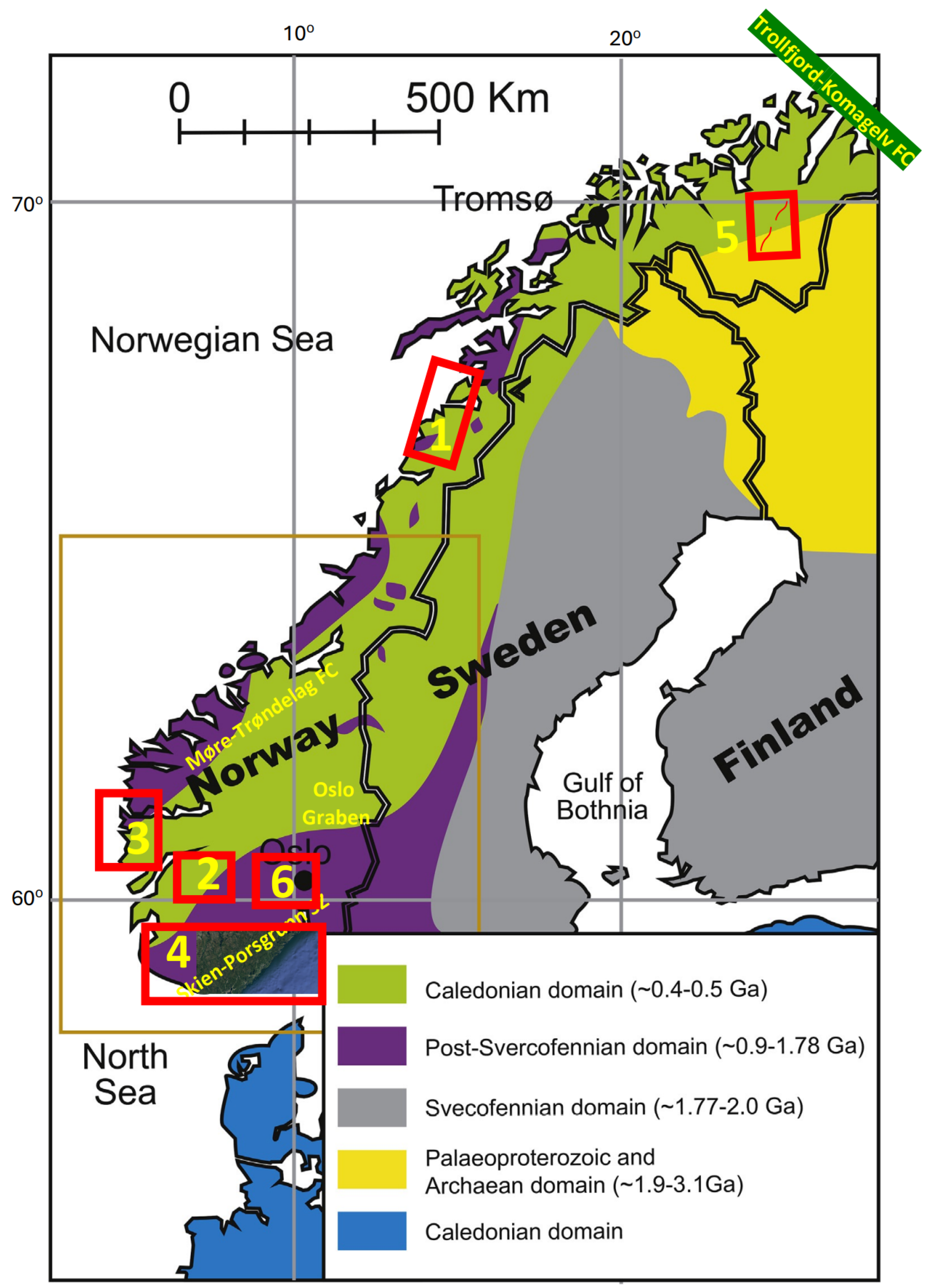
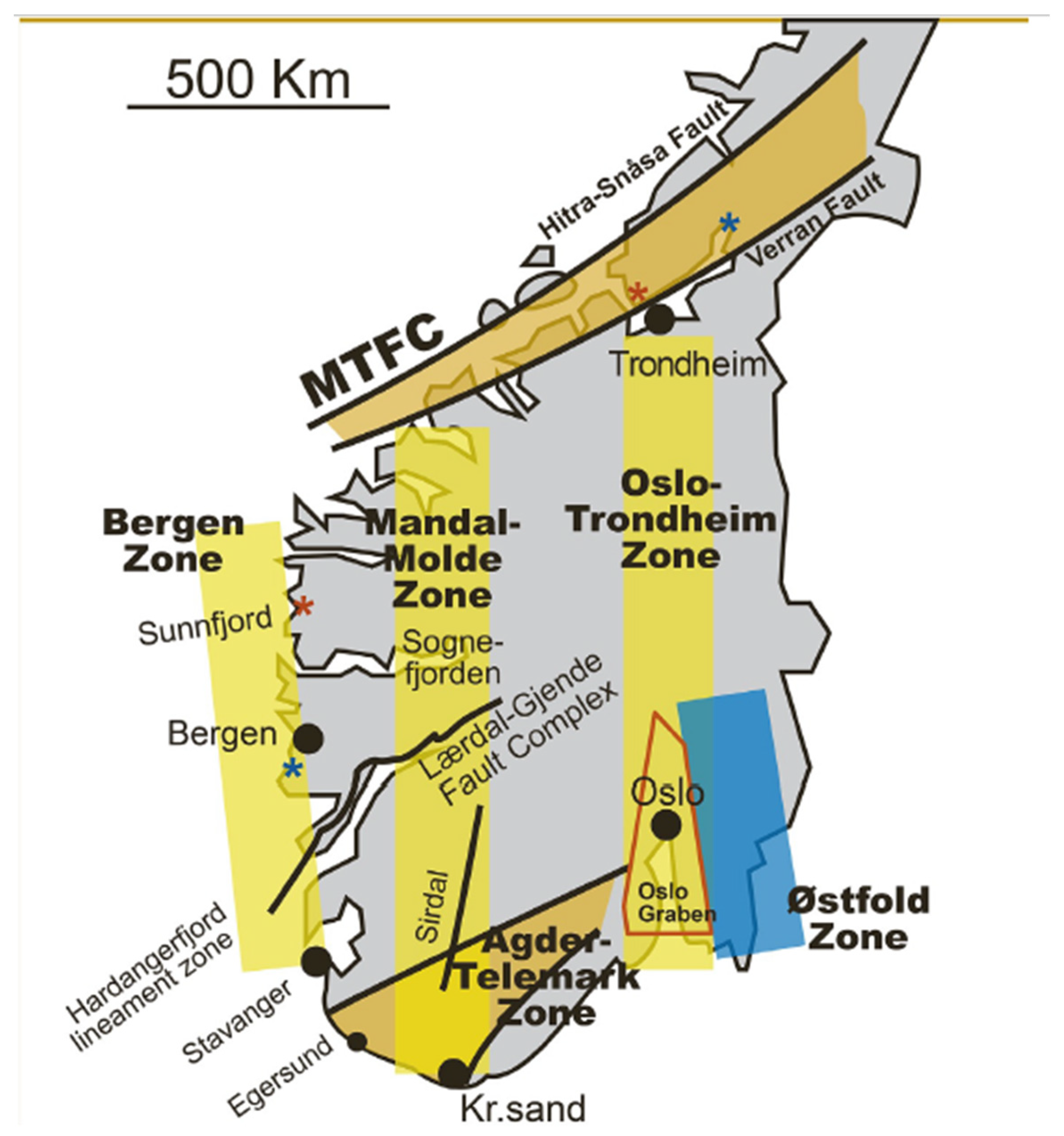
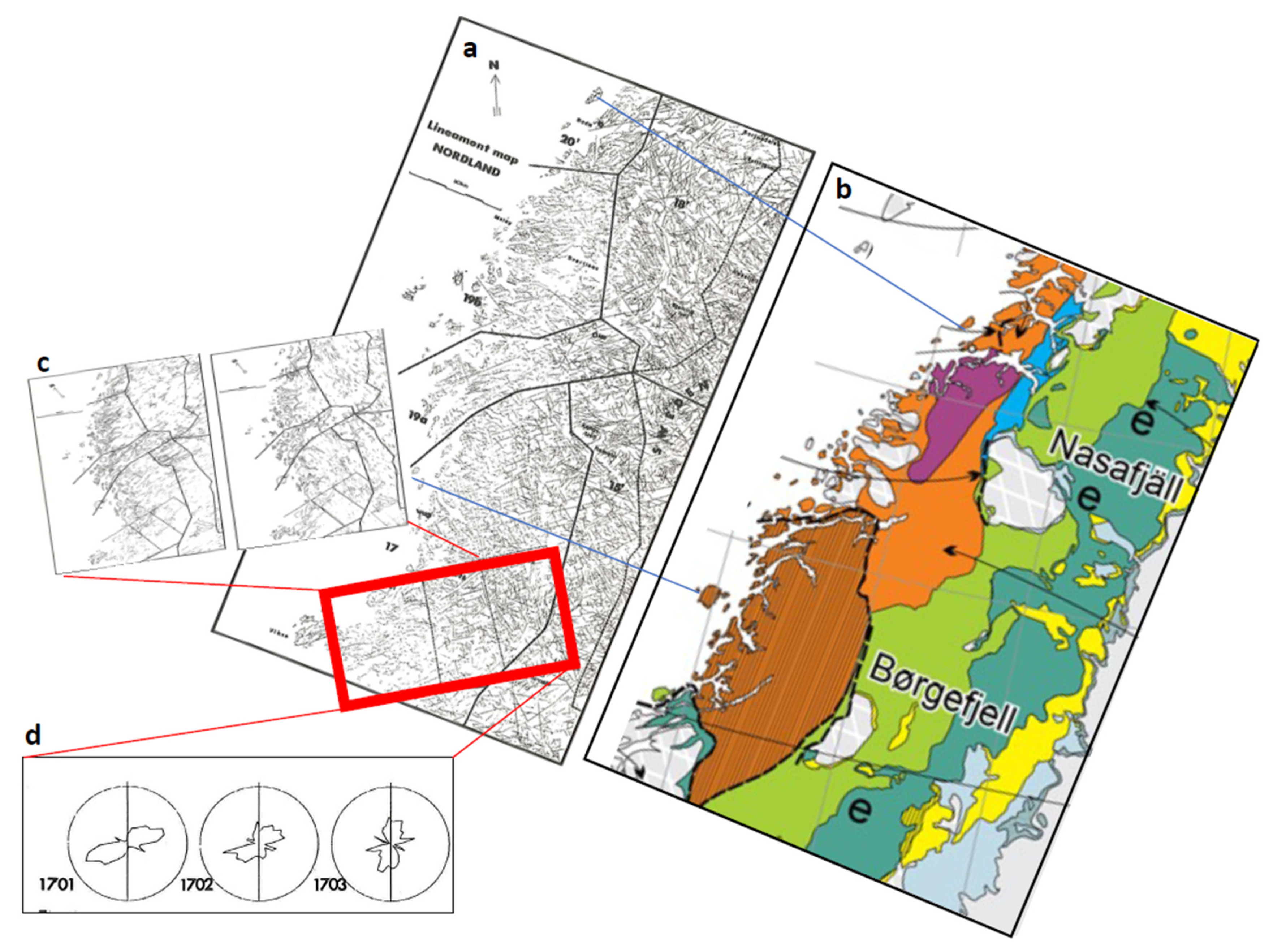

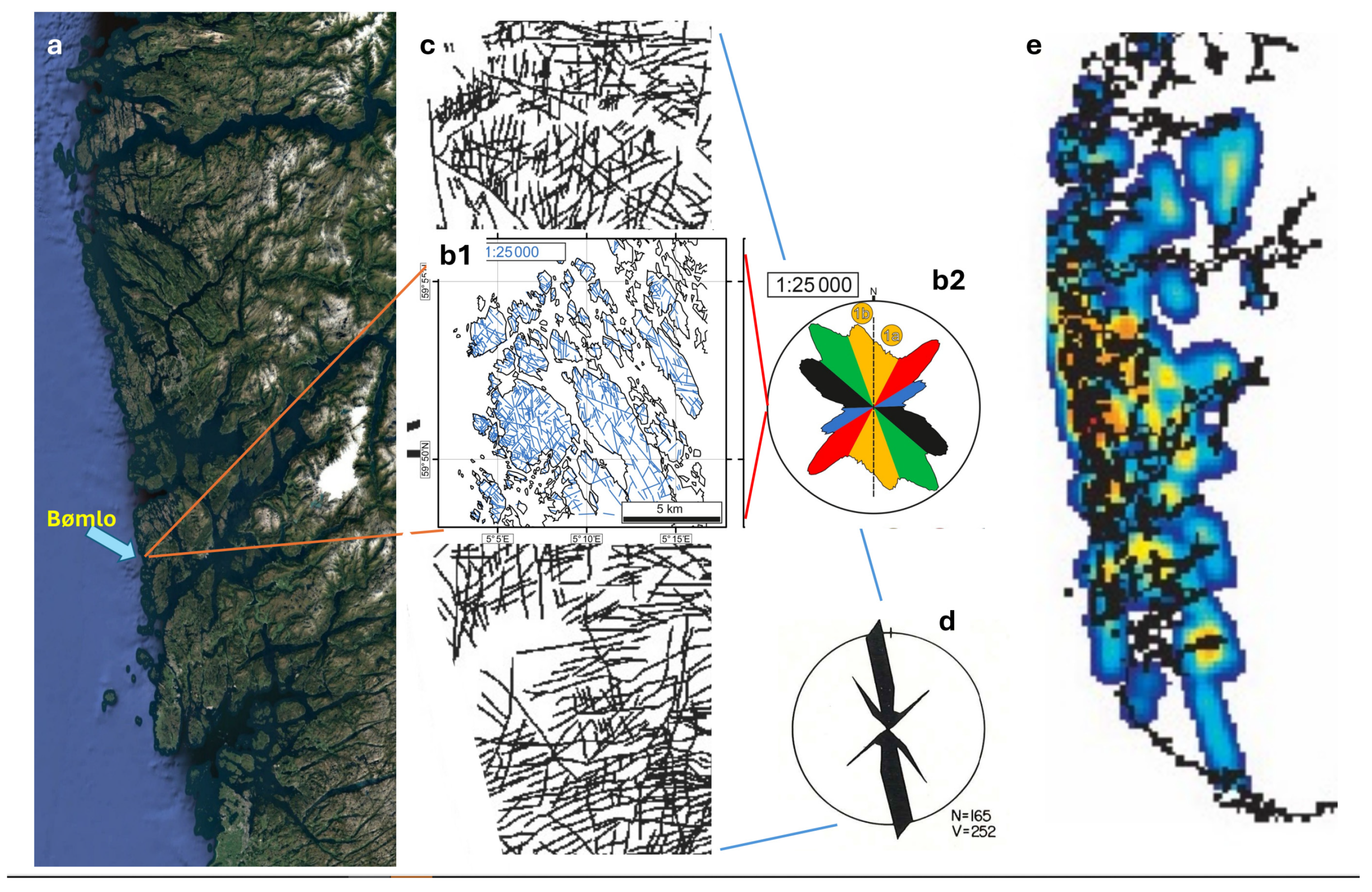
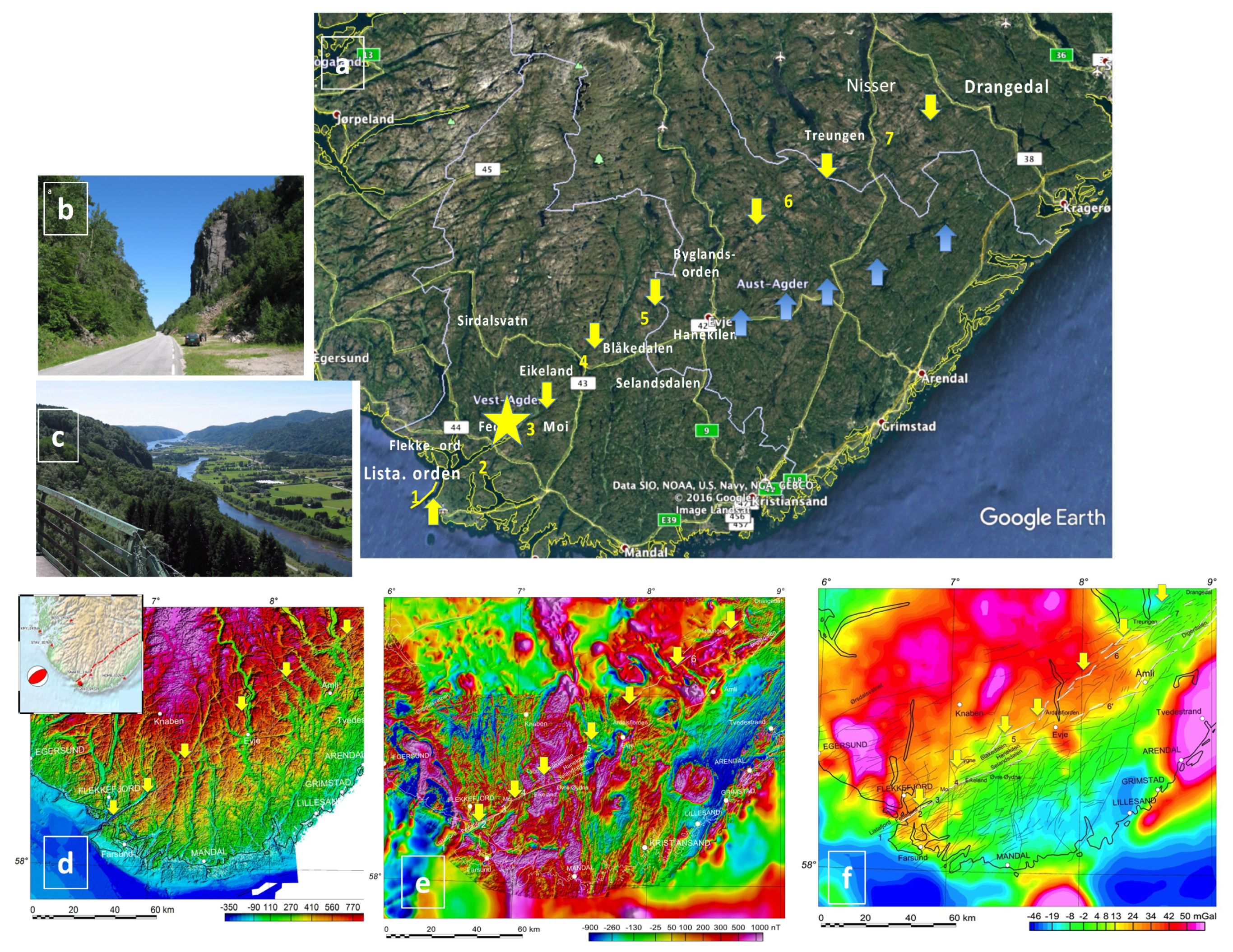
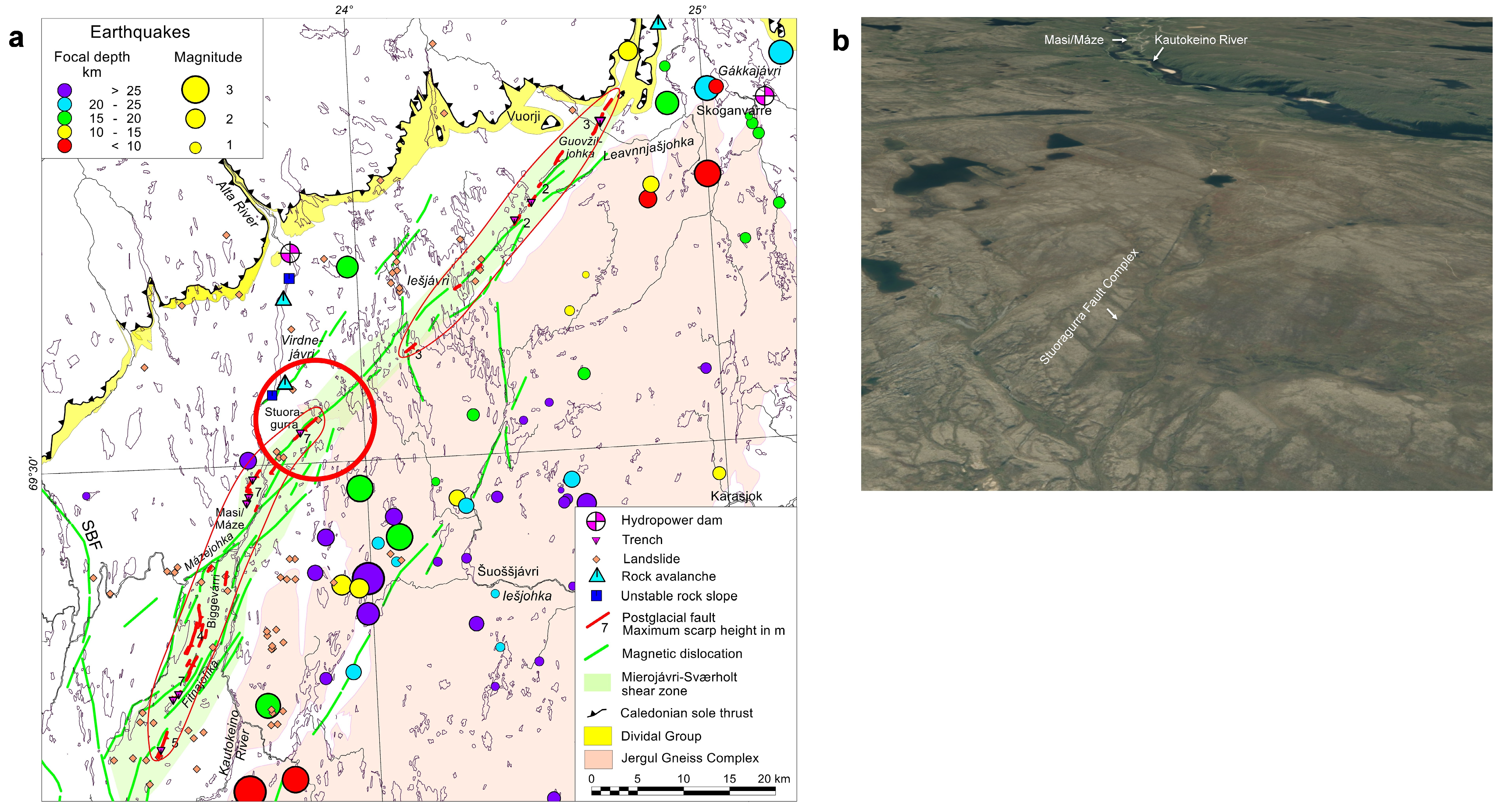
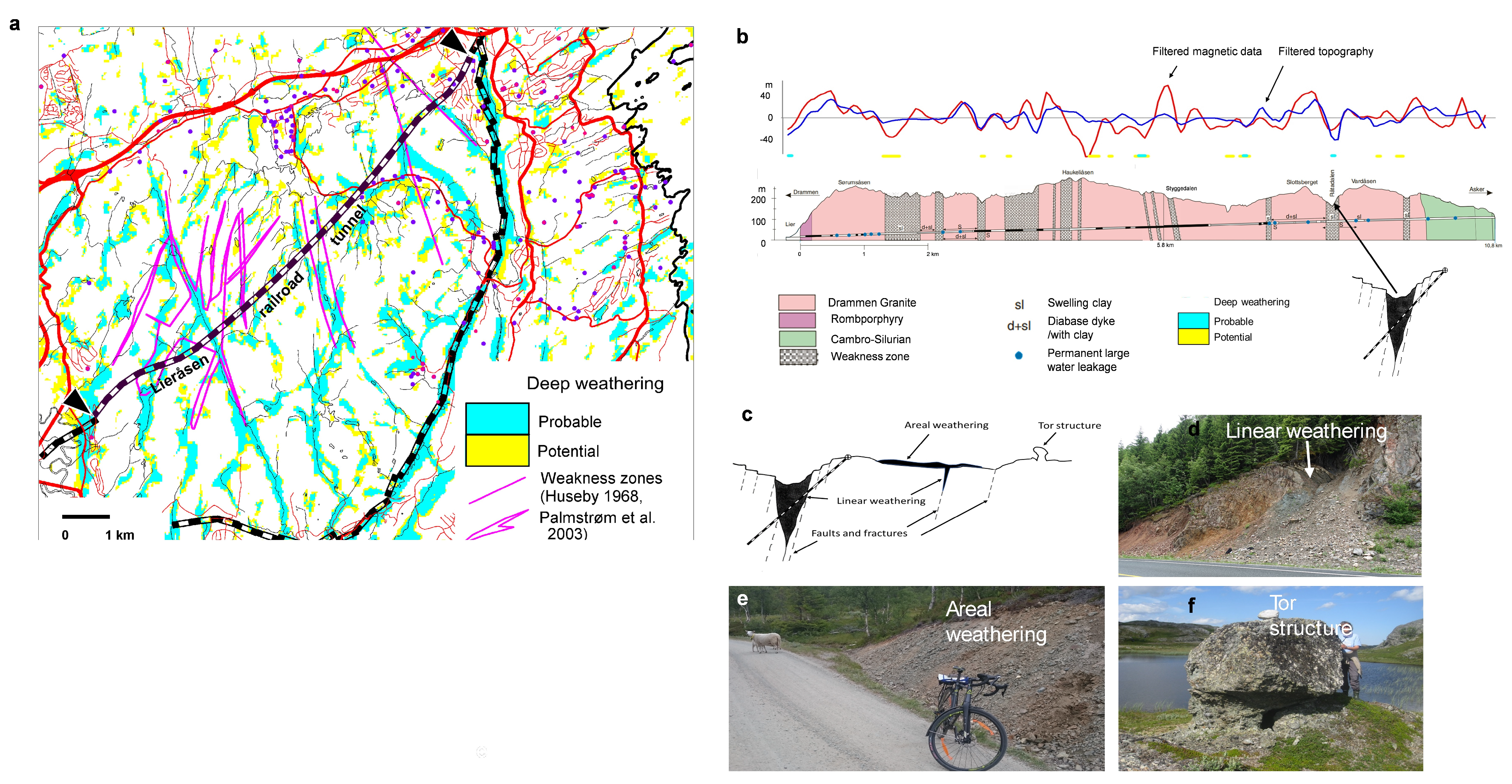
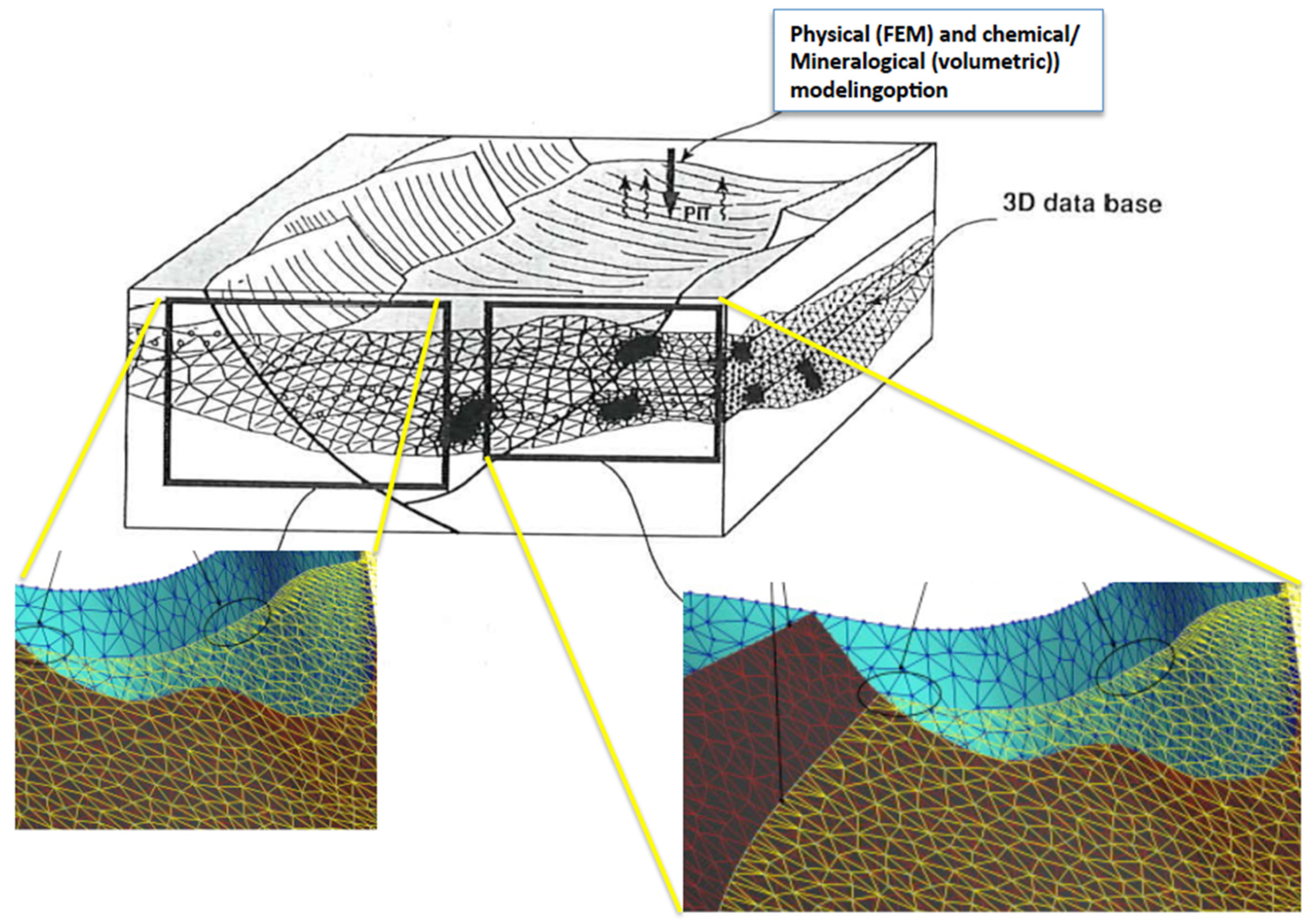
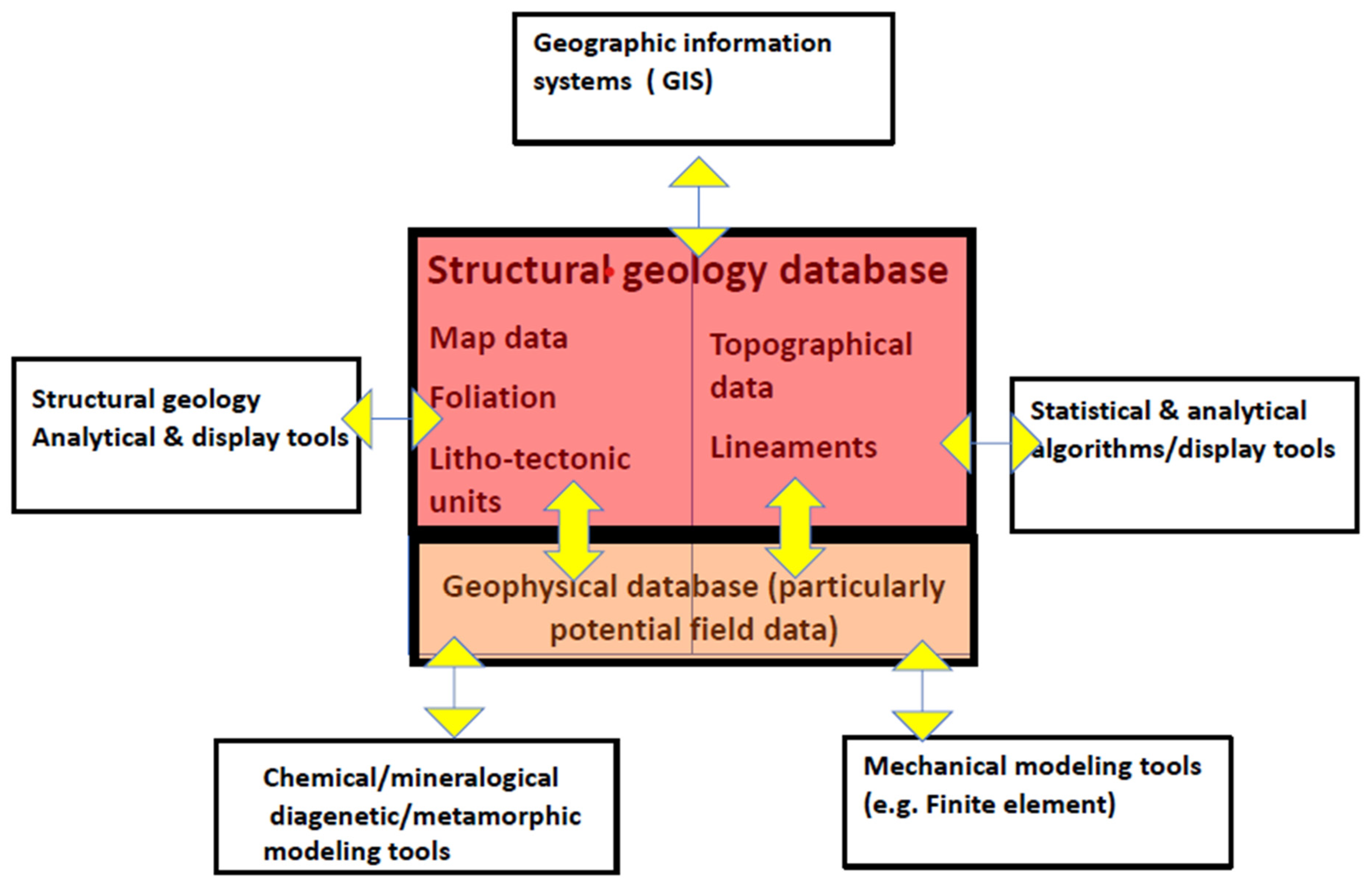

Disclaimer/Publisher’s Note: The statements, opinions and data contained in all publications are solely those of the individual author(s) and contributor(s) and not of MDPI and/or the editor(s). MDPI and/or the editor(s) disclaim responsibility for any injury to people or property resulting from any ideas, methods, instructions or products referred to in the content. |
© 2024 by the authors. Licensee MDPI, Basel, Switzerland. This article is an open access article distributed under the terms and conditions of the Creative Commons Attribution (CC BY) license (https://creativecommons.org/licenses/by/4.0/).
Share and Cite
Gabrielsen, R.H.; Olesen, O. The Concept of Lineaments in Geological Structural Analysis; Principles and Methods: A Review Based on Examples from Norway. Geomatics 2024, 4, 189-212. https://doi.org/10.3390/geomatics4020011
Gabrielsen RH, Olesen O. The Concept of Lineaments in Geological Structural Analysis; Principles and Methods: A Review Based on Examples from Norway. Geomatics. 2024; 4(2):189-212. https://doi.org/10.3390/geomatics4020011
Chicago/Turabian StyleGabrielsen, Roy H., and Odleiv Olesen. 2024. "The Concept of Lineaments in Geological Structural Analysis; Principles and Methods: A Review Based on Examples from Norway" Geomatics 4, no. 2: 189-212. https://doi.org/10.3390/geomatics4020011



